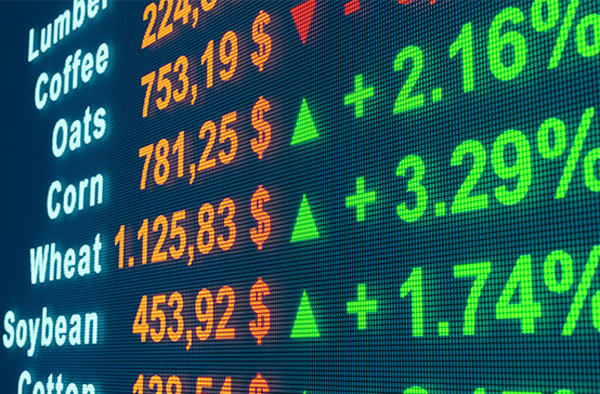

How 2024’s Election Could Reshape Your Portfolio
President Joe Biden’s withdrawal and endorsement of Vice President Kamala Harris has sent shockwaves through the political establishment, and while former President Donald Trump remains the frontrunner, the wind has certainly shifted in Harris’s favor. She’s managed to secure a majority of Democratic delegates, and she now has the endorsement of all top party leaders, including Barack Obama.
Harris’s campaign said it raised a jaw-dropping $100 million within 24 hours, which, if true, has to be a record. Users on the online betting platform Polymarket now believe the vice president has a 38% probability of winning in November, up from just 1% just a month earlier.

As a bit of trivia, Biden isn’t the first sitting president to choose not to seek reelection, but he’s the first to make the announcement so close to Election Day. Not including Richard Nixon, who quit the office outright in 1974, the last two presidents to forgo reelection were Lyndon Johnson, in 1968, and Harry Truman, in 1952.
GDP Surge Meets Market Rotation
This political upheaval comes at a time when the U.S. economy is sending mixed signals. On the one hand, gross domestic product (GDP) growth in the second quarter hit an impressive 2.8%, beating expectations and more than doubling the growth in the first quarter.

The S&P 500 is up about 14% this year, despite recent pullbacks as investors rotate out of high-flying tech stocks into smaller, undervalued companies. The shift appears to be partly driven by expectations of lower interest rates from the Federal Reserve.
In any case, these positive indicators—a solid economy and stock market—typically bode well for the incumbent party, giving Harris an edge.
Why Americans Feel Poorer in a Growing Economy
However, we can’t ignore the economic anxiety that many Americans are feeling right now. A recent survey by buy-now-pay-later company Affirm found that three in five Americans believe we’re in a recession, even though we’re not officially in one. This perception is influenced by inflation and higher living costs.
Credit card payment delinquencies are also rising at a concerning rate right now as Americans’ pandemic-era savings have run dry. The percentage of cardholders who are more than 30 days delinquent is at a 12-year high, while the percentage of those who are 60 days or more past due hit a new series high of around 2.6%.

The Battle Over Tech and Bitcoin
Last week, I discussed J.D. Vance, a former venture capitalist and Trump’s running mate. I indicated that Vance is likely to serve as the Trump campaign’s bridge to Silicon Valley’s deep pockets.
But Harris, 59, has similar connections as well. She served as California’s attorney general from 2011 to 2017 and then as senator from 2017 to 2021. As a result, she reportedly has long-term connections to Silicon Valley. The New York Times reports that, in past campaigns, the vice president has relied on Silicon Valley’s tech elites for donations. A recent CNN headline, in fact, reads that “Kamala Harris wants to be America’s first Silicon Valley president.”

An area I’m watching closely is the Bitcoin and cryptocurrency space. As someone who’s deeply involved in the sector through HIVE Digital Technologies, I believe the next administration’s stance on crypto could have significant implications for this emerging and yet important asset class.
Although Harris hasn’t made any statements for or against digital currencies in the past, her team has reportedly reached out to crypto-savvy figures like Mark Cuban. The Blockchain Association, the industry’s trade group, said that Harris presents a “fresh opportunity” to make inroads with the Democratic Party, which has historically not been as welcoming to digital assets and crypto mining as Americans on the political right have been, generally speaking.
Trump, on the other hand, has transformed himself into the ultimate pro-Bitcoin candidate after being “orange pilled” by Bitcoin mining executives at his Mar-a-Lago home last month. The former president posted on his social media platform Truth Social soon after the meeting that he wants “all the remaining Bitcoin to be made in the USA.”
Trump is speaking at the Bitcoin 2024 conference in Nashville tomorrow, July 27, and I’ll be sure to share my thoughts next week. Watch this space!

Index Summary
- The major market indices finished mixed this week. The Dow Jones Industrial Average gained 0.75%. The S&P 500 Stock Index fell 0.83%, while the Nasdaq Composite lost 2.08%. The Russell 2000 small capitalization index gained 3.47% this week.
- The Hang Seng Composite gained 8.49% this week; while Taiwan was down 3.28% and the KOSPI fell 2.27%.
- The 10-year Treasury bond yield fell 4 basis points to 4.193%.
Airlines and Shipping
Strengths
- The best performing airline stock for the week was Frontier, up 12.5%. Bombardier strong deliveries (39 versus consensus 32) drove revenue nearly 20% above consensus, with 19% growth in services also above. Adjusted EBITDA is 15% above consensus, according to UBS.
- According to the IATA, global air cargo demand registered a 15% year-over-year increase, supported by robust e-commerce demand and capacity constraints in ocean freight. The largest contributors to such strong growth were carriers from Asia Pacific and Europe, which together contributed roughly two-thirds of the increase.
- Boeing is tracking to deliver around 40 total aircraft this month, including 30 737 MAX and 3-4 787s. Goldman reads that Boeing continues to look like it is tracking to start ramping back up in the second half of this year following product quality improvement efforts in the first half.

Weaknesses
- The worst performing airline stock for the week was Ryanair, down 10.4%. With Delta Air Lines, the issue occurred on the busiest travel weekend of the summer, with over 90% booked loads, limiting reaccommodation. Among the select airlines reviewed, Delta/Spirit/United experienced the greatest negative impact. Raymond James estimates pretax impact for Delta/Spirit/United of $163M/$14M/$65M (with an EPS drag of $0.15/$0.10/$0.13).
- UPS second quarter results and lowered full year 2024 guidance were 11% and 9% below expectations. Fiscal year 2024 consolidated EBIT is projected to be 37% below fiscal year 2022 peak level. While this likely represents the bottom, the macro-outlook remains largely mixed, and an inflection point in the demand cycle remains elusive, according to BMO.
- The first quarter 2025 print from Ryanair was weak, with net income of €360mn significantly below expectations, driven by lower-than-expected fares: F1Q25 average fares were down 15% year-over-year versus Visible Alpha Consensus Data down 5% year-over-year. For the summer quarter (F2Q25), the company downgraded to “materially lower than last summer”, compared to previous guidance for fares to be flat to modestly up for the period, according to Goldman.
Opportunities
- According to Folha, Brazilian airlines will need to buy Embraer planes in return for financing from BNDES (National Bank for Economic and Social Development), as stated by the bank’s president, Mr. Aloizio Mercadante. The government expects, as a counterpart to the BNDES finance, GOL, LATAM and Azul, to buy planes from Embraer, as the Bank’s President highlights the lack of Embraer aircrafts in the airline’s fleet.
- According to Goldman, the weekly index indicated lower bottlenecks overall given the combination of lower container ship backlog results–particularly along the East Coast where backlogs were cut by more than half–and improved chassis dwell metrics at U.S. ports.
- Bank of America reports that Boeing deliveries to Chinese operators were halted pending additional validation of a lithium battery in the cockpit voice recorder. At the end of the first quarter, the OEM still had 70 aircraft related to Chinese operators in its inventories. June, six of the 34 MAX deliveries were from storage, marking the highest total since the start of the year. Should Chinese inventory deliveries resume, they expect this number to continue increasing throughout the second half of the year.
Threats
- Air Canada lowered its 2024 outlook reflecting a lower yield environment, lower-than-expected load factors in the second half of 2024, and competitive pressures in the international market. The carrier also sees 2024 ASM growth of 5.5%-6.5% versus its previous guidance of 6%-8% and adjusted EBITDA of $3.1B-$3.4B versus the previous guidance of $3.7B-$4.2B, according to CIBC.
- ISI reports that tanker stocks have faced renewed pressure of late, which they attribute to seasonal rate weakness (though for only one high-profile segment) as well as the on-again/off-again concerns about world peace ending this robust rate run.
- According to Raymond James, for Southwest Airlines, the mid-point of the third quarter 2024 guide implies EPS of $(0.31), well below consensus $0.23 forecasts. Guidance for year-over-year top line and non-fuel costs are worse. However, Southwest expects year-over-year RASM to inflect positively in the fourth quarter.
Luxury Goods and International Markets
Strengths
- Hermes reported earnings that exceeded expectations. Revenue rose by 13.3%, surpassing the analysts’ forecast of 11.5%, thanks to strong sales of Birkin and Kelly handbags, which start around $10,000 apiece. The company’s results tend to be more resilient than other luxury brands because it enjoys strong pricing power and is exposed to more affluent customers.
- Deckers, the maker of HOKA sneakers and UGG boots, reported earnings that exceeded expectations this week as well. The company raised its full-year earnings per share forecast. Net sales grew by 22% year-over-year, with UGG sales up 14% and HOKA sales soaring by 30%.
- Aston Martin was the top-performing S&P Global Luxury stock, rising 11.5% over the past five days. The shares increased after the car maker reported revenue for the second quarter that beat average analysts’ expectations.
Weaknesses
- LVMH’s sales growth slowed. The luxury group’s fashion and leather goods unit (the biggest division) rose by 1%, about half the gain expected by analysts, and much lower than the 21% growth seen one year earlier. Looking at the sales by region, China was the weakest market, where sales tumbled 14% in the quarter.

- Kering reported disappointing results, with net profits dropping 50% in the first half of the year, and issued another profit warning. Gucci unit sales, where the profits are most dependent on spending in China, fell 19%, worse than the analysts’ expected 17% decline.
- Faraday Future Intelligence was the worst-performing S&P Global Luxury stock, losing 10.75% in the past five days. Shares its market cap declined by 99.5% in a year.
Opportunities
- Royal Caribbean reported on Thursday second-quarter profits that beat expectations and raised its full-year outlook. The company also said it would start paying dividends again, for the first time since March 2020. Bookings are expected to remain strong.
- The Summer Olympics have officially begun in Paris, and this global event is expected to positively impact luxury sales. With Paris as the host city, there is heightened interest and tourism, driving demand for high-end goods. The influx of visitors and increased media attention on the city are likely to boost sales for luxury brands, capitalizing on the Olympic buzz.
- The United States reported second-quarter GDP at 2.8%, well ahead of the consensus of 1.9% and the prior quarter’s final 1.4%. The beat was largely driven by inventory build and government spending along with higher consumption in healthcare, housing, motor vehicles, and recreational goods and services among others, FactSet reported.
Threats
- Lululemon shares fell 10% on Thursday, to the lowest intraday since May 2020, after the company confirmed to Bloomberg News on Wednesday night that it had decided to pause on sales of its Breezethrough yogawear. In addition, Citi downgraded the stock to neutral from a buy rating due to weaker sales and increased competition.
- Ford reported lower-than-expected earnings and revealed it’s losing nearly $50,000 on each electric car it sells. Despite selling 23,957 EVs—up 61% from last year—the company attributed the poor results to high production costs and increased competition. This suggests it could be challenging for other car makers to achieve strong profits from EV sales.
- Trains to and from Paris were disrupted by what authorities called a “coordinated sabotage effort” ahead of the Olympic Games’ inaugural ceremony. Fires were set off at three critical rail-line nodes. The opening ceremony will go ahead as planned. Paris is on high alert with increased security patrols during the Olympic games.

Energy and Natural Resources
Strengths
- The best performing commodity for the week was Lumber, rising just 2.99% after falling about 25% since late March when the new home construction season never got started in earnest. Indonesia is working to structure new nickel investments where the Chinese can own no more than a 25% stake in the venture, as reported by Bloomberg.
- According to CLSA, Cleveland Cliffs (CLF) reported underlying second quarter EPS of $0.11 per share, beating consensus of $0.01. Adjusted 2Q24 EBITDA of $323 million beat consensus of $283 million. CLF do not provide specific profit guidance but cut FY24 capex to US$650-700 million and stated that it remains on track to achieve cost reductions of $30 per ton.
- Goldman sees the recent rebound in API2 coal prices into the range of $105-110 USD per ton as consistent with current fundamentals, and they maintain their 2024 annual/third quarter API2 forecasts at 110/106 USD per ton.
Weaknesses
- The worst performing commodity for the week was natural gas, dropping 6.16%, after it was reported there was a larger-than-expected rise in storage last week. Natural gas prices have dropped by 37% since June, with Hurricane Beryl shutting in some domestic production from the more lucrative international market prices.
- Copper dropped as base metals extended the worst weekly slump in almost two years, with a modest rate cut in China doing little to offset worries about demand in the world’s top commodities consumer. Prices for the metal viewed as an economic bellwether fell even after China increased support for the economy with surprise interest-rate cuts, according to Bloomberg.

- Oil slipped about 1.5% for the week, near a six-week low, as traders waited for fresh clues on market balances, including the outlook for U.S. stockpiles. The global benchmark fluctuated around $82 a barrel after shedding more than 3%, while West Texas Intermediate traded near $78, according to Bloomberg.
Opportunities
- China’s central government has approved Shanghai’s plan to build 29 gigawatts of offshore wind capacity, as the city works to cut emissions to meet Beijing’s ambitious climate targets, according to Bloomberg.
- Woodside Energy Group Ltd. has agreed to buy troubled U.S. liquefied natural gas export project developer Tellurian Inc. for about $900 million in a bet on rapid growth in global demand for the fuel, reports Bloomberg.
- India will remove import taxes on 25 critical minerals and ramp up efforts to develop small-scale nuclear reactors to speed its adoption of clean energy, Finance Minister Nirmala Sitharaman said in her budget speech. Duties on metals including copper, lithium, and cobalt will be lifted to aid the domestic development of sectors like renewable electricity and aerospace, she said in the speech, according to Bloomberg.
Threats
- China’s refined copper exports surged to a record last month as weak demand in the world’s biggest metals buyer prompted smelters to turn to overseas markets, Bloomberg reports. Shipments more than doubled to 157,751 tons in June from May, well above the previous all-time high of 102,000 tons in 2012.
- With lithium prices languishing near three-year lows and showing no signs a recovery is coming, attention is now turning to whether miners will be forced to rein in the supply of the battery metal. The price of the material that is vital to the energy transition has plunged by around 80% since late 2022, and Benchmark Mineral Intelligence sees the current glut deepening through 2027.
- Iron ore crumbled below $100 a ton as a policy meeting in China failed to deliver major stimulus, while supplies stayed strong. The outcome of the Third Plenum, a twice-a-decade conclave of Communist Party officials held last week, underwhelmed investors with few steps to boost metals demand or fix the property crisis, writes Bloomberg.
Bitcoin and Digital Assets
Strengths
- Of the cryptocurrencies tracked by CoinMarketCap, the best performer for the week was Cat in a Dogs world, rising 87.10%.
- Bitcoin edged up to the highest level in over a month as traders evaluated the implications of U.S. President Joe Biden’s decision to abandon his reelection bid. Bitcoin recovered losses to hover around $67,000 on Monday as markets reacted to the possibility of a Trump presidency, according to Bloomberg.

- Regulators approved the first U.S. ETF investing directly in Ether according to filings and statements from asset managers. The latest development paves the way for imminent trading of the ETFs, reports Bloomberg, and highlights a softening in the U.S. regulatory climate.
Weaknesses
- Of the cryptocurrencies tracked by CoinMarketCap, the worst performer for the week was Lido DAO, down 20.09%.
- India’s finance minister introduced an interim budget and kept the crypto tax rules unchanged in her recent address. The primary demand from India’s crypto industry was to reduce the controversial tax-deducted-at-source policy on crypto transactions from 1% to 0.01%, according to Bloomberg.
- The yen’s resurgence is causing a broad market selloff, driving the yuan higher and negatively impacting assets like Japanese stocks, gold, and Bitcoin. Investors are re-evaluating leveraged positions amid expectations that the interest rate gap between Japan and the U.S. will narrow, triggering widespread deleveraging and increased market volatility.
Opportunities
- In another sign that crypto is back in vogue, more new tokens have been listed on major digital-asset exchanges in the first half of this year than in all of 2023, Bloomberg reports. On higher volume exchanges including Binance and Bybit, coin listings are cumulatively up11.6% to 2,0066 in the first six months of the year.
- About a year and half after the collapse of crypto friendly banks in the U.S., European players are pushing to reinvigorate the market for around the clock payments in the digital asset sector. As reported by Bloomberg, AMINA Bank and Sygnum Bank have debuted real time payment and settlement networks. They are targeting the gap left by Silvergate Exchange Network.
- South Korea’s right-wing political party has proposed delaying the taxation of cryptocurrency gains by three years. If passed, the country’s crypto gains taxation will be pushed back from the beginning of 2025 to 2028. The right-wing people power party’s president has pledged to push back crypto gains, writes Bloomberg.
Threats
- Ether, the second-largest cryptocurrency, plummeted by 7.8% to $3,160, leading to a sharp decline in digital assets following a significant drop in equities. With Bitcoin also down 2%, and experts warning that if investor sentiment continues to sour and the yen strengthens further, Ether could tumble even lower.
- The OECD has urged nations to improve their implementation of owner-info rules, highlighting severe deficiencies in nearly half of the 112 jurisdictions assessed in their framework for beneficial ownership disclosure. The group also notes progress in tax transparency for real estate and cryptocurrency with 58 nations agreeing to the Crypto Asset Reporting Framework.
- Celebrity tokens launched on the Solana blockchain have seen an average decline of 94% from their all-time highs within a month, with the majority experiencing dramatic drops in market value and only a few remaining actively promoted by the celebrities themselves. This has raised concerns about their legitimacy and long-term viability.

Defense and Cybersecurity
Strengths
- Rolls-Royce is investing over £1 billion to upgrade its XWB jet engines, aiming to enhance their performance and durability, especially in sandy and hot climates. This comes following criticism from key customers like Emirates, while also improving fuel efficiency and reliability for various aircraft models.
- Northrop Grumman has received a $1.46 billion contract modification from the U.S. Navy to provide nine E-2D Advanced Hawkeye aircraft, with support for the Navy and Japan, to be completed by March 2029. This will aid in enhancing defense capabilities and situational awareness in the Pacific region.

- The best performing stock in the XAR ETF this week was Virgin Galactic, rising 15.33%, after Arizona-based Sun State Builders and Texas-based Parkway Construction completed Virgin Galactic’s new spaceship manufacturing facility in Mesa, Arizona. The facility will begin assembling next-generation Delta spaceships in early 2025.
Weaknesses
- Nvidia’s stock declined on Thursday due to concerns about the AI trade’s sustainability, heightened by Alphabet’s earnings report and a subsequent tech selloff. This highlighted investor anxiety about returns on AI investments and affected other chip makers like Samsung and Broadcom.
- Ukraine’s troops withdrew from the village of Prohres in Donetsk amid intensified Russian assaults in the Kharkiv region. Moscow is ramping up forces in strategic locations and preparing for new offensives, aiming to push Ukrainian forces further from the border and closer to Kharkiv City.
- The worst performing stock in the XAR ETF this week was BWX Technologies, falling 2.8%. Barclays downgraded BWX Technologies to underweight from equal weight, citing risks to its EBITDA target and continued pressure on its core Naval propulsion business, despite raising the price target to $90.
Opportunities
- On July 16, 2024, Rheinmetall BAE Systems Land (RBSL) announced significant progress in the Challenger 3 Main Battle Tank trials, emphasizing crew safety and advanced vision systems, with rigorous testing of the Rheinmetall AG Trailblazer technology on the second pre-series vehicle at RBSL’s Telford facility. The goal is to finalize the design and prepare for deployment by 2027.
- Pratt & Whitney, a division of RTX, has delivered an F100 engine to Poland to bolster the readiness of its F-16 Fighting Falcon fleet, with additional engines expected to be delivered throughout the year.
- Rolls-Royce is developing a smaller version of its Ultrafan engine demonstrator to explore technology for next-generation narrow-body jets, indicating a potential return to the narrow-body market while continuing strong sales in wide-body engines, according to CEO Tufan Erginbilgic at the Farnborough Airshow.
Threats
- The Israeli military ordered the evacuation of a part of Gaza’s humanitarian zone for an operation against Hamas militants. This caused thousands of Palestinians to flee repeatedly in search of safety amidst ongoing violence and poor living conditions.
- Leonardo CEO Roberto Cingolani warned that the next-generation Tempest fighter jet, a collaborative effort among the UK, Japan, and Italy, might face delays and increased costs due to its complex development. This potentially could require additional funding and new partnerships, such as with Saudi Arabia, to meet its 2035 target.
- Poland has used its control over a key Chinese rail export route to the EU to exert pressure on Belarus, successfully reducing the number of migrants crossing its border by linking migration and freight transit in diplomatic talks with China.
Gold Market
This week, gold futures closed at $2,449.20, up/down $19.80 per ounce, or 0.80%. Gold stocks, as measured by the NYSE Arca Gold Miners Index, ended the week higher/lower by 1.87%. The S&P/TSX Venture Index came in off 2.99%. The U.S. Trade-Weighted Dollar rose 0.27%.
Strengths
- The best performing precious metal for the week was gold, but still down 0.80%. MAG Silver provided its second-quarter attributable silver production of 2.19 million ounces, above CIBC’s expectations of 1.82 million ounces due to a combination of higher total tons processed, higher-than-expected grades, and recoveries.
- According to Bloomberg, holdings in exchange-traded funds (ETFs) backed by gold are starting to inch higher. The last time they set a new low was in mid-May, suggesting that an enormous run of outflows that started (with some interruptions) late in 2020 may finally be ending.

- Vizsla Silver’s inaugural Preliminary Economic Assessment (PEA) for the Panuco gold-silver project in Mexico confirmed Stifel’s investment thesis that this mine will be an extremely high-margin mining operation. The economics are extremely robust, and the project quality continues to stand head and shoulders above peers, according to Stifel.
Weaknesses
- The worst performing precious metal for the week was silver, down 5.70%. According to Bloomberg, China’s gold imports plunged last month for retail consumption, a sign that the nation’s buyers are deterred by the precious metal’s elevated prices amid a sluggish economy. Purchases from overseas by the world’s biggest bullion consumer fell nearly 60% to 58.9 tons, the lowest since May 2022, according to official data released Sunday.
- Artemis Gold announced it had responded to a wildfire evacuation order issued across a region including its Blackwater Mine. The company proactively removed all non-essential staff and contractors from the site and took precautions to safeguard assets, with essential staff remaining on site. Management expects to resume full-scale construction activities in the short term, according to Canaccord.
- The gold premium on physical gold on the Shanghai Stock Exchange, which it has held since late last year, has now flipped to a discount, indicating a waning in demand. China’s central bank paused purchases last April.
Opportunities
- Goldman finds that fear (measured as low consumer confidence), income (i.e., their China Current Activity Indicator), low China interest rates, and especially low gold prices all boost China gold demand. They estimate that a 10% drop in the Shanghai gold price boosts physical China gold demand by 16%.
- Canaccord shows that past Federal Reserve easing cycles over the last 20+ years have corresponded with higher gold prices, and they expect to see gold continue to set new record highs in 2024. The market is now pricing in a 98% probability of a first Fed cut in September. Another supporting factor for gold, in their view, is rapidly rising debt levels. The CBO recently increased its forecast for the U.S. deficit to $2 trillion for 2024, 7% of GDP, and for deficits to average 6.3% of GDP over the next decade.
- Announcing the Union Budget, India’s Finance Minister Nirmala Sitharaman announced a cut in gold and silver import duties from 15% to 6% “to enhance domestic value addition in gold and precious metal jewelry in the country.”
Threats
- Chow Tai Fook’s shares slid to the lowest since June 2020, after the gold seller reported a 20% on-year retail sales drop in the first quarter. Analysts attribute the decline to soft gold demand amid historically high gold prices and weak macroeconomic conditions, according to Bloomberg.
- Gold Royalty announced preliminary second-quarter Total Revenue, Land Agreement Proceeds and Interest a bit below BMO’s expectations. Given recent acquisitions and the ramp-up of portfolio assets, timing could potentially be off until the assets achieve a steady run-rate.
- Fresnillo’s second-quarter gold production was -13% versus JPMorgan’s estimate, and silver output was 6% higher than JPMorgan’s estimate. The beat on silver was largely due to stronger output at Cienega, Juanicipio and San Julian, despite lower output at Fresnillo. In gold, the miss is largely due to rain-related disruption at Herradura.


U.S. Global Investors, Inc. is an investment adviser registered with the Securities and Exchange Commission (“SEC”). This does not mean that we are sponsored, recommended, or approved by the SEC, or that our abilities or qualifications in any respect have been passed upon by the SEC or any officer of the SEC.
This commentary should not be considered a solicitation or offering of any investment product. Certain materials in this commentary may contain dated information. The information provided was current at the time of publication. Some links above may be directed to third-party websites. U.S. Global Investors does not endorse all information supplied by these websites and is not responsible for their content. All opinions expressed and data provided are subject to change without notice. Some of these opinions may not be appropriate to every investor.
Holdings may change daily. Holdings are reported as of the most recent quarter-end. The following securities mentioned in the article were held by one or more accounts managed by U.S. Global Investors as of (06/30/2024):
Southwest Airlines
Air Canada
United Airlines
Delta Air Lines
Boeing
Hermes
Deckers
LVMH
Kering
Lululemon
Vizsla Silver
*The above-mentioned indices are not total returns. These returns reflect simple appreciation only and do not reflect dividend reinvestment.
The Dow Jones Industrial Average is a price-weighted average of 30 blue chip stocks that are generally leaders in their industry. The S&P 500 Stock Index is a widely recognized capitalization-weighted index of 500 common stock prices in U.S. companies. The Nasdaq Composite Index is a capitalization-weighted index of all Nasdaq National Market and SmallCap stocks. The Russell 2000 Index® is a U.S. equity index measuring the performance of the 2,000 smallest companies in the Russell 3000®, a widely recognized small-cap index.
The Hang Seng Composite Index is a market capitalization-weighted index that comprises the top 200 companies listed on Stock Exchange of Hong Kong, based on average market cap for the 12 months. The Taiwan Stock Exchange Index is a capitalization-weighted index of all listed common shares traded on the Taiwan Stock Exchange. The Korea Stock Price Index is a capitalization-weighted index of all common shares and preferred shares on the Korean Stock Exchanges.
The Philadelphia Stock Exchange Gold and Silver Index (XAU) is a capitalization-weighted index that includes the leading companies involved in the mining of gold and silver. The U.S. Trade Weighted Dollar Index provides a general indication of the international value of the U.S. dollar. The S&P/TSX Canadian Gold Capped Sector Index is a modified capitalization-weighted index, whose equity weights are capped 25 percent and index constituents are derived from a subset stock pool of S&P/TSX Composite Index stocks. The NYSE Arca Gold Miners Index is a modified market capitalization weighted index comprised of publicly traded companies involved primarily in the mining for gold and silver. The S&P/TSX Venture Composite Index is a broad market indicator for the Canadian venture capital market. The index is market capitalization weighted and, at its inception, included 531 companies. A quarterly revision process is used to remove companies that comprise less than 0.05% of the weight of the index, and add companies whose weight, when included, will be greater than 0.05% of the index.
The S&P 500 Energy Index is a capitalization-weighted index that tracks the companies in the energy sector as a subset of the S&P 500. The S&P 500 Materials Index is a capitalization-weighted index that tracks the companies in the material sector as a subset of the S&P 500. The S&P 500 Financials Index is a capitalization-weighted index. The index was developed with a base level of 10 for the 1941-43 base period. The S&P 500 Industrials Index is a Materials Index is a capitalization-weighted index that tracks the companies in the industrial sector as a subset of the S&P 500. The S&P 500 Consumer Discretionary Index is a capitalization-weighted index that tracks the companies in the consumer discretionary sector as a subset of the S&P 500. The S&P 500 Information Technology Index is a capitalization-weighted index that tracks the companies in the information technology sector as a subset of the S&P 500. The S&P 500 Consumer Staples Index is a Materials Index is a capitalization-weighted index that tracks the companies in the consumer staples sector as a subset of the S&P 500. The S&P 500 Utilities Index is a capitalization-weighted index that tracks the companies in the utilities sector as a subset of the S&P 500. The S&P 500 Healthcare Index is a capitalization-weighted index that tracks the companies in the healthcare sector as a subset of the S&P 500. The S&P 500 Telecom Index is a Materials Index is a capitalization-weighted index that tracks the companies in the telecom sector as a subset of the S&P 500.
The Consumer Price Index (CPI) is one of the most widely recognized price measures for tracking the price of a market basket of goods and services purchased by individuals. The weights of components are based on consumer spending patterns. The Purchasing Manager’s Index is an indicator of the economic health of the manufacturing sector. The PMI index is based on five major indicators: new orders, inventory levels, production, supplier deliveries and the employment environment. Gross domestic product (GDP) is the monetary value of all the finished goods and services produced within a country’s borders in a specific time period, though GDP is usually calculated on an annual basis. It includes all private and public consumption, government outlays, investments and exports less imports that occur within a defined territory.
The S&P Global Luxury Index is comprised of 80 of the largest publicly traded companies engaged in the production or distribution of luxury goods or the provision of luxury services that meet specific investibility requirements.
































